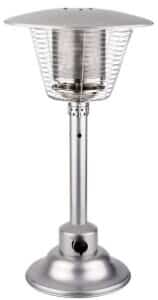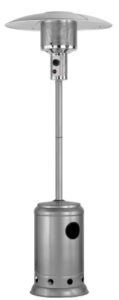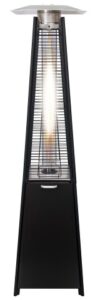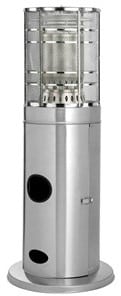LPG Gas Patio Heater is NOT a Gas Heater Indoor | Carbon Monoxide Hazard
Just DON’T do it. That is the simple message for people considering using an LPG gas patio heater (outdoor gas heater) for gas heater indoor use (indoor gas heater).
Whilst an indoor gas heater is extremely safe, as it is designed for gas heater indoor use, the same is not true for an LPG gas patio heater.
An LPG gas patio heater (outdoor gas heater) is also very safe, but only when operated outside where they are designed to be used.
Using any gas patio heater for gas heater indoor use (indoor gas heater) is an extreme safety hazard, as they can generate carbon monoxide.
Doing so is a dangerous idea that can be potentially fatal to residents.
What is an Outdoor Gas Heater – LPG Gas Patio Heater?
 The most common kind of outdoor gas heater is an LPG gas patio heater.
The most common kind of outdoor gas heater is an LPG gas patio heater.
These are typically either tall gas outdoor mushroom heater style or shorter round outdoor gas heater (LPG patio heater).
Some are also designed for use in the garage or as industrial blow heaters.
A gas patio heater like this is intended for large spaces with continuous ventilation and should never be used at home or in smaller enclosures.
Using gas cooking appliances as an LPG gas heater indoor (indoor gas heater) is also dangerous.
Can You Use an Outdoor Gas Heater – LPG Gas Patio Heater Inside?
You cannot use an outdoor gas heater (gas patio heater) as a gas heater indoor (indoor gas heater).
An LPG gas patio heater designed for an outdoor space can produce poisonous Carbon Monoxide – CO – as part of its combustion gases.
 If you use an LPG gas patio heater (outdoor gas heater) as an LPG gas heater indoor (indoor gas heater), its exhaust gases can get trapped inside your home, causing a potential CO poisoning hazard.
If you use an LPG gas patio heater (outdoor gas heater) as an LPG gas heater indoor (indoor gas heater), its exhaust gases can get trapped inside your home, causing a potential CO poisoning hazard.
You can use an LPG heater inside only if the heater is originally designed as an indoor gas heater (gas heater indoor).
That includes a linear gas fireplace or wall-mounted LPG heater.
This is because indoor gas heaters (gas heater indoor) have cleaner gas emissions and may be vented outside.
Some indoor gas heaters are vent-free, but regardless, an indoor gas heater (gas heater indoor) often has cleaner gas exhaust and complies with specific industry standards.
Are Indoor Gas Heaters Safe? Different Indoor Gas Heater Specifications
Indoor gas heaters are safe.
Australia and New Zealand have some of the most stringent standards on indoor gas heater (gas heater indoor) combustion emissions of any country in the world.
 As a result, our indoor gas heaters are very safe to use.
As a result, our indoor gas heaters are very safe to use.
The gases of primary concern are CO (carbon monoxide) and NOX (nitric oxide and nitrogen dioxide), produced during incomplete combustion.
To be certified in Australia and New Zealand, indoor LPG heaters must meet or surpass these steep standards.
The same is not true for an LPG gas patio heater (outdoor gas heater).
They are not required to meet the gas heater indoor emission standards because they are intended for outdoor use, with unrestricted ventilation.
Why Don’t They a Build Outdoor Gas Heater – LPG Gas Patio Heater the Same?
Meeting a gas heater indoor standards would add to the cost of designing and manufacturing of outdoor gas heater (gas patio heater) models.
If you compare the prices of two types of heaters, you will see that indoor gas heaters (gas heater indoor) cost more.
The manufacturers of a outdoor gas heater, trying to keep their units affordable, don’t design and build their heater the same way.
Nothing is wrong with this practice as long as the consumer only uses the LPG gas patio heater (LPG gas patio heaters) outdoors, as intended.
Radiant Outdoor Gas Heater – LPG Gas Patio Heater
 To be used safely, a radiant outdoor gas heater (LPG gas patio heater) needs continuous ventilation, so it’s impractical to heat the air with a convection heater.
To be used safely, a radiant outdoor gas heater (LPG gas patio heater) needs continuous ventilation, so it’s impractical to heat the air with a convection heater.
For this reason, most LPG gas patio heater models are radiant heaters, which have a warming effect similar to basking under the sun.
A radiant outdoor gas heater (LPG patio heater) allows specific spaces within an area to be heated, primarily warming only the people and objects in front of the unit.
Amongst the advantages of a radiant outdoor gas heater (gas patio heater) is that they are generally a low-cost option and require no electrical connection, which would be problematic outdoors.
These are great heaters as long as they remain outdoors.
Blower Gas Heater
 Commercial blower gas heater are typically used in warehouses, workshops, garages, factories, transport terminals, breeding sheds, and greenhouses.
Commercial blower gas heater are typically used in warehouses, workshops, garages, factories, transport terminals, breeding sheds, and greenhouses.
They are not suitable for gas heater indoor domestic use, and when in use, ample fresh air ventilation must be provided.
It is also important that the minimum room volume requirements be observed as specified by the manufacturer.
Once again, these are excellent heaters as long as they are used according to the manufacturer’s instructions and safety advice.
Carbon Monoxide

Properly functioning gas appliances ensure complete combustion and are quite safe when used as intended.
As discussed, outdoor gas heaters (LPG gas patio heater) may generate carbon monoxide, typically due to incomplete combustion, hence the need for better and unrestricted ventilation.
If you accidentally inhale carbon monoxide, you may feel persistent tiredness, shortness of breath, headaches, nausea, vomiting, and, in severe cases, loss of consciousness or even death.
If you experience any signs of carbon monoxide poisoning while operating any gas appliance, you should stop using it immediately, move to an area where you can breathe fresh air, and seek medical attention.
Combustion and Carbon Monoxide (CO)
All indoor gas appliances, domestic and industrial, produce water vapour, Carbon Dioxide, heat, and usually very small amounts of Carbon Monoxide.
However, a gas patio heater (outdoor gas heater) can produce significant amounts of carbon monoxide.
If installed and maintained correctly, an indoor gas heater provides quick and efficient heating and the products of combustion do not create hazardous situations.
If an appliance is not correctly installed and maintained or has been modified, the combustion products might change and become hazardous to the people around it.
Sometimes, it is obvious when a gas appliance malfunctions, as it produces sooty smoke, red or yellow flames, or poor performance, but sometimes you may not notice anything at all.
If Carbon Monoxide (CO) is produced and escapes the appliance into the surrounding air, it will not be obvious (no smell or taste) but very dangerous.
Gas appliances must be correctly installed and serviced every two years to maintain good combustion and safe, efficient operation.
Great Indoor Gas Heater Alternatives
 There are lots of indoor gas heater (gas heater indoor) models that are designed and certified for safe indoor use.
There are lots of indoor gas heater (gas heater indoor) models that are designed and certified for safe indoor use.
Look for the certification label on the unit.
Indoor gas heaters (gas heater indoor) are broadly grouped as portable (vent-free) or flued heaters.
Within these groups are sub-groups of radiant, convectors, radiant-convectors, power flued, flued radiant, and wall heaters.
Virtually all are available in both Natural Gas and LPG indoor gas heater model versions.
For an indoor gas heater (gas heater indoor), gas input is expressed in MJ/hour, while heat output is measured in kW/hour.
Generally speaking, greater gas input equals increased heat output, considering the relative energy efficiency ratings of the compared indoor gas heater models.
LPG indoor gas heaters in Australia are all tested and labelled for energy efficiency with Star Ratings. To learn more, please see A Review of Your Indoor Gas Heater Choices
Keep Your Family Safe
So in summary:
- Never use LPG gas patio heaters (outdoor gas heater) as a gas heater indoor.
- Only use an LPG indoor gas heater (gas heater indoor) designed for the indoors inside your home
- Keep your LPG gas patio heater (outdoor gas heater) outside where it can be used safely
- Always follow all the manufacturers’ instructions and safety advice
